eOrganic authors:
Emily Marriott, University of Illinois
Michelle Wander, University of Illinois
Source:
Cheyenne Christianson, Grazing Acres Dairy Farm
Introduction
Cheyenne and Katy Christianson and their children have been producing organic milk for almost 20 years on Grazing Acres, their farm in Chetek, Wisconsin. Cheyenne prioritizes soil and herd health, drought resilience, and self-sufficiency over productivity, and these values guide decision-making on the farm. As a result, Cheyenne uses practices such as grazing tall pasture, growing summer annuals, mob grazing, and feeding soil biology.
Farm Overview and History
The Christiansons bought their farmland (formerly a neglected and foreclosed conventional dairy farm) and 50 Holsteins in 1993 and immediately began to transition to organic production. Cheyenne learned to value organic principles from his father and wanted the farm to become certified organic as soon as possible. By 1995-96, they were using only organic inputs. They became certified organic and began shipping organic milk in 1999. Of the farm's 280 acres (Fig. 1), 240 are tillable and according to Cheyenne, “Everything is in hay and pasture. We can graze over the whole farm. We don't have a set number of acres [for grazing], although we tend to graze certain fields more and take hay off others... We will get the cows over the whole farm generally over the course of the year.” Cheyenne likes to experiment as he farms and frequently tries new practices. For example, he often now relies on annual forages such as oats, cereal rye, and triticale to extend the grazing season.
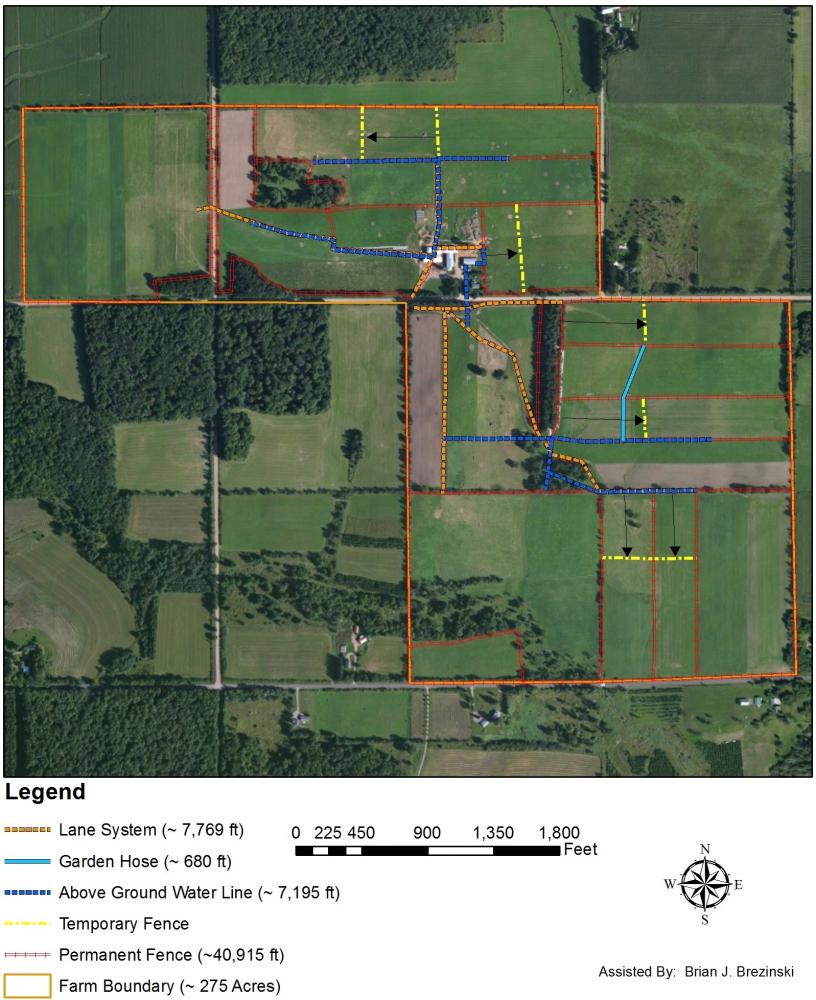
Figure 1. Farm layout, fencing and aboveground watering system. Figure credit: River Country RC&D.
Cheyenne's goal is for the farm to be completely self-sufficient, producing all their hay, baleage, and bedding from the property. He believes his current herd size may need to be reduced to achieve this in all years. As a strictly grass-fed dairy, it is very important to have enough high-quality feed to keep all animals in good condition.
Milk is sold to Organic Valley through the Grassmilk program. Grazing Acres has been 100% grass-fed since 1998 and joined Organic Valley's Grassmilk truck route in 2013.
Climate and Soils
Grazing Acres Farm is located in northwestern Wisconsin where winters are very cold and summers are fairly warm. The area receives about 33 inches of precipitation each year, distributed fairly evenly. Soils are primarily well-drained silt loams with sandy loam subsoils and moderate water holding capacity.
Farm Infrastructure
The farm has two coveralls and a stall barn with flat surface stalls and insulated walls. When they first purchased the farm, Cheyenne had to address stray voltage issues and high iron levels in the water. Cheyenne believes the high iron in the water was causing copper deficiency in some animals, manifesting as a reddening of the coat color on the shoulder blades. After adding hydrogen peroxide to the water to oxidize the iron and installing a water filtration system, incidences of copper deficiency have been much reduced. Water is run throughout the farm with black polyethylene pipe. There is no pasture irrigation at this point but Cheyenne is considering installing some on a small scale, as he believes that having 20–40 irrigated acres could have a huge impact during a drought year.
Herd Size, Composition, and Milk Production
Grazing Acres currently has a herd of about 180 Holsteins, comprised of about 70 milking cows, 100 heifers, and 10 bulls and bull calves. The herd is derived entirely from the original 50 cows Cheyenne bought in 1993. Because of low culling rates, the herd size increased considerably over time. A series of drought years (2004–2009, 2012–2013) stressed the system, highlighting that the farm was overstocked. Cheyenne began downsizing the herd in 2011, selling extra bulls and culling older cows with occasional cell-count issues. In the future, Cheyenne will sell heifers and/or cows to reduce the herd to his goal of around 120 head.
Average daily milk production fluctuates seasonally at Grazing Acres. Typical daily production is about 40 lb/cow, and drops to a seasonal low of 30 lb/cow. From 1999 to 2006 with a mature herd, annual milk production was about 13,000–14,000 lb/cow. During the worst of the drought years, annual production dropped to about 9,000 lb/cow. Cheyenne estimates that annual milk production now averages about 10,000 lb/cow.
Free-choice salt is available at milking and sometimes out on the pasture. Free-choice kelp is available in the coveralls year-round (they go through 1.5–2 tons/year). Minerals are also provided free choice.
Winter Feeding and Housing
In the winter, cows are fed mostly baleage (round bales) with some hay. They use a feeder wagon and three round-bale feeders. The wagon is stocked with higher quality bales. One of the round feeders will have second or third crop, and the other will have dry hay alternating with first-crop baleage. Dry hay is available most of the time. The youngest stock are housed in a shed. The bigger heifers stay outside with a bedded pack and a good windbreak. Outside animals have two coveralls—one with bedded pack and one with feeders—and they walk back and forth. Water tanks are in the sheds in the winter. Two to three hundred round bales are needed for bedding each year.
Key Practices
Soil Fertility
For Cheyenne, growing high-quality forages begins with soil fertility. His fertility strategy emphasizes feeding the soil biology with high-carbon material to maximize soil nutrient cycling and availability. In Cheyenne's view, his farm has two sets of livestock—his cows and his soil biology. He believes that the biology of the soil is as important, if not more important, than his cows. Therefore, he ensures that the cows leave enough plant biomass behind to feed earthworms and other soil organisms. Winter bedding consisting of straw and manure is also applied to fields to provide a fertility boost when fields are tilled.
The farmland had very low fertility when Cheyenne and Katy purchased it in 1993, testing low for all nutrients. In 1996, Cheyenne began working with MidWestern BioAg to help improve the farm's fertility. He generally follows Albrecht's mineral-balancing principles, but has adopted a more gradual approach to fertilization, preferring to emphasize soil-building practices to enhance cycling and availability of the nutrients already in his soil while keeping costs low.
Over time, Cheyenne has been regularly applying all nutrients except potassium (K). Cheyenne was initially (in the 1990's) reluctant to apply K in spite of soil tests showing deficiencies, as he had observed many neighboring dairy farms experiencing issues with excessive soil K levels that led to negative impacts on herd health. He hoped that improvements in soil biological activity would increase available K, but his sandy soils had small K reservoirs. They did see large differences in pasture productivity in fields with sufficient K over those with very low K levels. Therefore, when they began applying potassium sulfate around 2010, they saw tremendous increases in productivity.
Semi-truck loads of rock phosphate were applied to the farm in 1995 and 2002. Micronutrients such as zinc, copper, and manganese have been applied three times as sulfate salts. Boron tends to be applied more often, but not every year. Cheyenne would like to apply boron and sulfur every year. In particular, he would like to raise soil sulfur levels, as he believes that sulfur may be key in building high-quality protein in forages. In 2015, trace minerals (2–3 lb/acre) were mixed with rock phosphate as a carrier and spread over the farm. In 2011, trace minerals were applied with gypsum as a carrier. In addition, Cheyenne used high calcium lime in 2011 and 2012 (1 ton/acre) to raise calcium levels. Prior to 2011, only about 1.0–1.5 tons/acre of lime had been applied in total.
Soil Testing
Cheyenne typically conducts soil tests on about 3 fields every 2–3 years. He usually chooses a poor, a moderate and a productive field and uses the test results to formulate fertilization practices for the whole farm. In 2013, he sampled 10 fields, representing about half of the farm (Table 1). Cheyenne used the soil tests along with other resources to determine application rates for fertilizers and lime, generally following Albrecht's mineral-balancing principles. He typically applies fertilizers at lower rates than what agronomic consultants recommend, but has increased fertilization rates over the last few years in an effort to raise nutrients above minimum soil test levels.
Table 1. Soil test results for 2013, 0–6 inch sample depth.
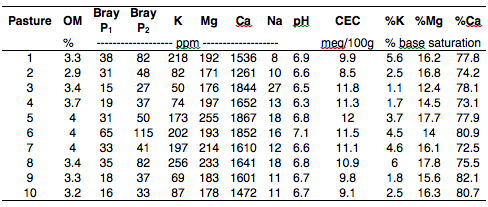
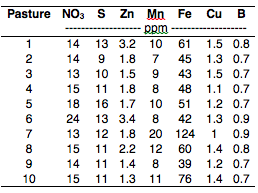
Pasture Composition, Renovation, and Summer Annuals
Pastures are typically composed of alfalfa (10–20%), red clover, naturalized volunteer white clover (a ladino-type), and orchard grass or quack grass (Fig. 2). When a pasture is reseeded, Cheyenne uses a mix of alfalfa, ryegrass, red clover, timothy, and often orchard grass—seeding each at a rate of 1 lb/acre. Cheyenne has purchased some improved seed varieties, primarily focusing on later-maturing varieties of grasses, but in general he does not purchase expensive seed. Cheyenne prefers not to have orchard grass in every field because it matures so fast in the spring. In the past, Cheyenne would have considered alfalfa a weed, but he has come to value its drought tolerance, and is considering increasing alfalfa in some fields that are predominantly used for hay.
Figure 2. This is a typical pasture. White clover is a naturalized volunteer. Photo credit: Cheyenne Christianson.
When a pasture is renovated, Cheyenne amends the soil with winter bedding material consisting of deep straw and manure (bedded pack) for 2 consecutive years. Enough bedded pack is created each year to amend 20–30 acres. The bedded pack is typically tilled into the soil, but sometimes the bedded pack manure is top-dressed and grazing or cutting is delayed in the spring to allow the earthworms to work it into the soil. When pastures are tilled, Cheyenne wants to feed as much organic material back into the soil as possible to feed the soil biology and offset the negative effects of tillage. Usually the bedded pack is spread raw and tilled in the same day to capture as much N as possible. Cheyenne uses a Howard Rotavator to keep tillage in the top 4–6 inches. Although Cheyenne prefers to keep the tillage shallower, sometimes the amount of material he is trying to incorporate—pasture sod and bedding pack—necessitates deeper tillage to about 6 inches. Pasture renovation and tillage also provides an opportunity to grow summer annuals. In general, Cheyenne likes to have 10–20 acres planted to summer annuals as insurance in drought years, as well as to provide high-quality forage in the fall when pasture productivity is typically waning. Summer annuals also provide versatility since they can be grazed or cut for stored feed. In the past, it has been easy to select pastures for renovation, but in recent years he has had such high quality pasture, he has been reluctant to till.
A common cropping sequence Cheyenne uses when renovating pasture includes two years of summer annuals (Fig. 3). In this renovation sequence, the bedded pack (manure and straw) is applied in August and the pasture is rotavated. Then the field is planted with fall oats and cereal rye and grazed in October and November, providing high-quality feed going into winter. In the spring, the cereal rye is grazed or cut for bedding. Bedded pack is applied and the field is rotavated. Japanese millet is seeded and grazed or cut for baleage. Fall oats and cereal rye are planted again in August and grazed in fall. The cereal rye is grazed in the spring, allowing other fields to grow for an additional week or two before grazing. The cereal rye is allowed to regrow and is then cut for bedding. This system has worked very well. After cereal rye, the field regrows as 100% red clover with no seeding. In the following year, grasses start to fill in and by the third year after cereal rye, the pasture is a perfect blend of grass and red clover, without having to seed (Fig. 4).

Figure 3. The figure illustrates a common cropping sequence used when renovating pasture.
Figure 4. Pasture in third year after a cereal rye crop, with ideal composition. This pasture was not seeded; all plants are volunteer. In the first year after cereal rye, the field was solid red clover. Some grass started to grow in the second year. In the third year, lots of grasses are filling in. Photo credit: Cheyenne Christianson.
Grazing Practices
Paddocks are 8–12 acres in size, which gives Cheyenne enough room to run equipment. For grazing, paddocks are subdivided with polywire into smaller units. The herd is divided into four groups throughout the growing season: milk cows, nurse cows with calves (Fig. 5), heifers (can also include some dry cows), and a bull herd with yearlings and two-year-olds. Each group is moved twice per day, every day. Sometimes milk cows are moved a third time in the late afternoon. Typical rest time for the pastures is 30–50 days. Cheyenne prefers a long rest time partly due to a string of drought years when it was better to leave grass longer to protect the soil and reduce water loss. In years with sufficient rain, he thinks it would be more advantageous to harvest one crop and then grow another. By waiting, they give up some yield, but they gain drought tolerance in the meantime. The weather forecast is an important tool Cheyenne uses to decide when to cut a field for hay or baleage. Once a pasture is cut, the soil dries out quickly. Cheyenne likes to make sure that rain is coming before a field is cut to ensure that the field will have enough moisture to regrow.
Figure 5. Nurse cows and calves grazing pasture that would typically be considered too tall and mature. Although this is not high enough quality forage for long-term grazing, the animals look good and do well with short periods on this type of pasture. Photo credit: Cheyenne Christianson.
For this farm, ideal turn-in height on pastures is 18–24 inches tall, varying somewhat by the field composition. Cheyenne aims for 80–85% consumption, leaving about 15% as residual (Fig. 6). Residual height is commonly 4–8 inches. He believes that tall grazing with long rest times between grazing events and longer residual heights contribute to the soil biology and helps reduce parasite loads.
Figure 6. The right side of the photo shows the condition of this pasture at grazing and the left side shows residual after grazing. The level of consumption is very good, even though the pasture is tall. Consumption is much better than 10–15 years ago on this type of pasture. Cheyenne attributes this to improvement in the digestibility and nutrition of their pastures. Photo credit: Cheyenne Christianson.
Spring and Fall Transition On and Off Pasture
In early spring, animals are on bedded pack and fed hay or baleage. Cheyenne carefully watches the weather and how fast fields are growing to determine when to start grazing in the spring. Animals are transitioned to grass over 2–3 weeks, while Cheyenne watches regrowth and recovery of pastures. This gives most fields a chance to increase in height. Cheyenne starts cattle grazing older stands during the day, usually choosing fields with a higher percentage of orchard grass during their transition onto pasture. The cattle return to hay or baleage at night. Once cows start on grass, Cheyenne finds that they aren't interested in hay or baleage anymore and he must have high-quality stored feed to tempt them. After 2–3 weeks, cattle are moved to 100% pasture. In most years, they start grazing full grass in mid-May. This system allows the cows to transition gradually from drier to wetter feed and gives the pastures a chance to really start growing. It is especially helpful in years when cool, wet, spring weather lingers. Grazing grass too soon in spring can damage pasture plants and greatly reduce productivity over the course of the season. In the late fall, bigger heifers get grass once per day plus baleage or hay to try to ration remaining pasture. The goal is to keep cows on pasture until the first of December. They intentionally leave grass in the fall to build plant reserves; these fields will begin growing first in the spring. Cheyenne notes that this technique works especially well in pastures with a lot of orchard grass.
Mob Grazing
Mob grazing is an important tool Cheyenne uses to build soil and protect it from water loss (Fig. 7). By grazing cows on tall pasture for a short period of time, considerable material is trampled. This material becomes substrate for soil organisms, helping to increase soil organic matter and water holding capacity. For Cheyenne, mob grazing means grazing mature fields (typically waist high or higher) with a goal of having 50% of the forage consumed and 50% trampled, compared to the 80–85% consumption goal for regular grazing. They typically mob graze 2–3 fields per year, deliberately grazing them last in the spring rotation, usually in mid– to late June. For more information on Cheyenne's mob-grazing experiences, see What We're Learning About Dairy Mobbing.
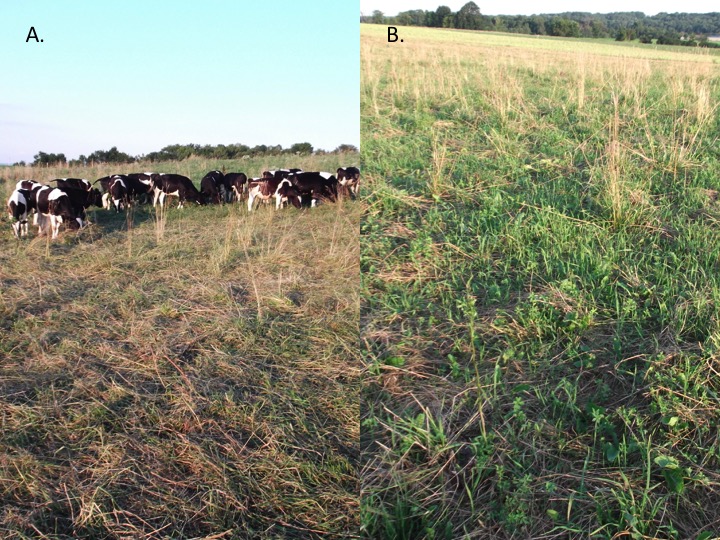
Figure 7. A. Heifers mob grazing at end of July/early August in 2011. This is the first grazing event of the year for this field. B. Same field a few days after mob grazing. According to Cheyenne, “The field looks rough for a bit right after mobbing but comes back beautifully.” Photo credit: Cheyenne Christianson.
Forage Quality
Over time, Cheyenne has found that palatability and consumption of the pastures has improved throughout the farm. Cows no longer refuse alfalfa. The palatability and quality of orchard grass has improved over time and now it does not get rust in the fall, most likely due to improved soil fertility. Even in fields where grasses are heading out, Cheyenne can get really good consumption. Ten to fifteen years ago, consumption on a similar field would have been half of what it is today. Forage testing (Table 2) also has shown high energy levels and high digestibility. Cheyenne attributes the improved palatability and consumption of forages to improvements in soil microbial activity and fertility.
Figure 8. Typical pasture conditions at grazing. Cheyenne doesn't usually graze milk cows on pasture that is beyond the early maturity stage. Photo credit: Cheyenne Christianson.
Table 2. Forage analysis results for the pasture in Fig. 8 (2011). High-quality pasture for dairy production has 20–23% crude protein, 38–42% neutral detergent fiber, and net energy for lactation of 0.62–0.68 Mcal/lb (Soder and Muller, 2003).
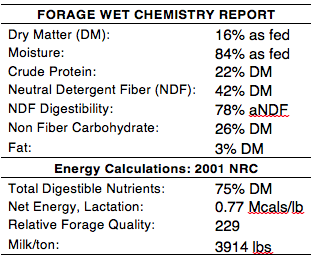
Cheyenne relies on manure consistency and body condition as indicators of pasture quality. He does not conduct regular forage analysis, but observes how much the cows eat and how much they leave behind. He can tell by their behavior if something is wrong. For example, sometimes with older pasture, refusal is an indication that the pasture needs to be renovated. On this farm, milk production is secondary. Since Cheyenne does a lot of experimenting and pushes the limits of his system, he doesn't have as much milk production as he might. With a no–grain system, it is not unusual to see a several hundred pound fluctuation in milk production when the cows change forages or grazing heights.
For cows on 100% pasture, it is critical to have a balanced diet. Diets with too much protein and too little fiber may lead to loose, thin cows with high milk urea nitrogen (MUN) levels (Hutjens and Chase, 2012). So Cheyenne prefers taller pastures which contain more fiber, as he believes it provides a better balance for the cows.
Case Study Takeaway Points
- With his grazing system design, Cheyenne aims to balance the needs of soil organisms and his dairy herd.
- Increases in soil quality have led to increases in forage quality, allowing Cheyenne to graze taller pastures, which in turn protects soil and provides drought tolerance.
- For Cheyenne, mob grazing is an important tool used to feed and protect the soil and increase the available water capacity of his grazing system.
- Close observation and constant experimentation allow Cheyenne to gain a deeper understanding of his system and continuously make improvements.
References and Citations
- Soder, K. and L. Muller. 2003. Pasture quality and quantity [Online]. p. 7–15. In Proceedings from Nutrition of Dairy Cows on Pasture-Based Systems. 31 March 2003. Grantville, PA. Available at: http://extension.psu.edu/animals/dairy/nutrition/forages/pasture/articles-on-pasture-and-grazing/pasture-quality-and-quantity (verified 10 March 2016).
- Hutjens, M. and L. E. Chase. 2012. Interpreting milk urea nitrogen (MUN) values [Online]. eXtension Foundation. Available at: http://articles.extension.org/pages/11322/interpreting-milk-urea-nitrogen-mun-values (verified 10 March 2016).
Additional Resources
- Christianson, C. 2012. What we're learning about dairy mobbing. Graze. Available online at: http://www.grazeonline.com/learningdairymobbing (verified 11 March 2016).
- Darby, H. and M. Gamroth. 2013. Strategies for extending the grazing season on organic farms [Online]. eXtension Foundation, eOrganic Community of Practice. Available at: http://articles.extension.org/pages/18648/strategies-for-extending-the-grazing-season-on-organic-farms (verified 13 May 2016).
- Kersbergen, R. 2013. Maximizing organic milk production and profitability with quality forages [Online]. eXtension Foundation, eOrganic Community of Practice. Available at: http://articles.extension.org/pages/24980/maximizing-organic-milk-production-and-profitability-with-quality-forages (verified 13 May 2016).
- McCrory, L. 2012. Vibrant grass-based, no grain organic dairy [Online]. Northeast Organic Dairy Producers Alliance. Available at: http://www.nodpa.com/ff_may_2012.shtml (verified 16 March 2016).
- Sullivan, K. H. 2010. Transitioning organic cows on and off pasture [Online]. eXtension Foundation, eOrganic Community of Practice. Available at: http://articles.extension.org/pages/18675/transitioning-organic-cows-on-and-off-pasture (verified 18 October 2016).
- Voth, K. 2015. Mob grazing—definitions, benefits, drawbacks and implementation [Online]. On Pasture. Available at: http://onpasture.com/2015/04/13/mob-grazing-definition-benefits-drawbacks-and-implementation/ (verified 10 March 2016).



